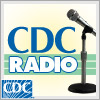Preview and download pre-produced radio PSAs from the CDC PSA library below. We
rely on radio stations to convey these messages. Check back often as we are constantly
adding new PSAs. We appreciate your help communicating these important messages.
If you have questions or concerns, please contact us at
cdcradio@cdc.gov.
Patients with Central Lines - What You Need to Know to Avoid a Bloodstream Infection PSA (:60)

This 60 second PSA is based on the March, 2011 CDC Vital Signs report which indicates bloodstream infections in patients with central lines are largely preventable when healthcare providers use CDC-recommended infection control steps. Created: 3/1/2011 by Centers for Disease Control and Prevention (CDC). Date Released: 3/1/2011. Series Name: CDC Radio.
Press Play to listen to this CDC PSA
Running time = 0:59
To save the PSA, right click the "Save this file" link below and select the
"Save Target As..." option.
How are we
doing?
Podcasting Resources
Contact Us:
- Centers for Disease Control and Prevention
1600 Clifton Rd
Atlanta, GA 30333 - 800-CDC-INFO
(800-232-4636)
TTY: (888) 232-6348 - Contact CDC–INFO


